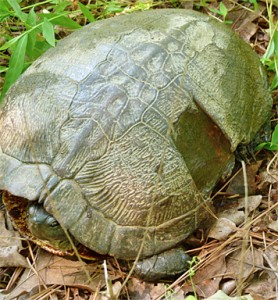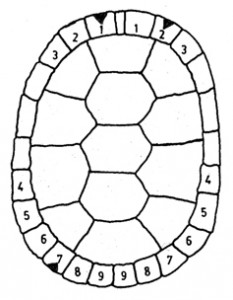We have many turtles living in our Wetlands of at least five different species. This is the time of year when we see some of those turtles up on dry land hiking about the landscape.
There are at least three reasons for aquatic turtles to crawl out of the relative safety of their watery habitat, to bask in the sun, to seek out a new stream, lake, or pond to live in, or to lay eggs. We see some of our five resident species of turtle out basking on rocks and logs throughout the year here in the Carolina Piedmont. But when we start seeing them out hiking the trails it usually means that the females are up looking for suitable nest sites, bare ground in which to dig a nest hole.
It’s not uncommon to see a turtle walking along one of the paths here at the Museum from late April into June. It’s turtle nesting season. Each year the sight of the turtles gets me to wondering whether the turtles that I see are the same group of turtles. Am I seeing the same handful of females or are there many individuals coming ashore?

There’s only one turtle in the Wetlands that is easily recognizable, even from a great distance. I’ve mentioned this turtle many times before in this Journal. I call her “Chip” because she has a large chunk of shell missing from the left side of her carapace. It was Chip’s young that we released in the Wetlands back in April.
Last spring we saw her walking about the trails on at least three separate days. We would never have known that it was Chip who made those three trips ashore had it not been for her damaged carapace. We would have most likely assumed that it was a different turtle that we saw each day that she was observed.

So, if you were to start a project to find out how many turtles are coming ashore to lay eggs, whether it was a small group of individuals or a large number of turtles, how would you know who’s who? You have to mark them.
An accepted way of marking turtles which does no harm to them is to file out a notch or notches into the marginal scutes of their shells (marginal scutes are the shell segments on the outside, or margin, of the carapace). The scutes are numbered as seen in the diagram at left (you can use letters if you like, a,b,c…). The marginal scutes that are not numbered are attached to the plastron (bottom shell) of the turtle and are not suitable for notching.
But you can’t just go around catching turtles and carving notches in their shells. So, we had to get a permit from the state before going into action. Thanks to the quick work of Animal Department Director, Sherry Samuels, and Exhibits Developer, Michelle Kloda a permit was in hand by mid April.
I secured a file, a tape measure, slapped together some data sheets and a few other odds and ends and I was ready to go.
Now all we need is some turtles!
To be continued…
we saw Chip at 6 PM Thursday May 24 about 10 feet from the entrance to the boardwalk
Great news. Since she’s already easily recognizable we don’t need to worry about marking her. I do, however, hope to run into her again so that I can get a measurement of her shell, she’s a big one and I’m curious as to just how big. It’d also be interesting to know if she makes more than one trip ashore. One turtle that I’ve marked was found again the following day in a different location! But more on that in part 2 of “Turtles: Evolution of a Project” coming soon.
Thanks, and let us know if you spot her again.
Cool, Greg!